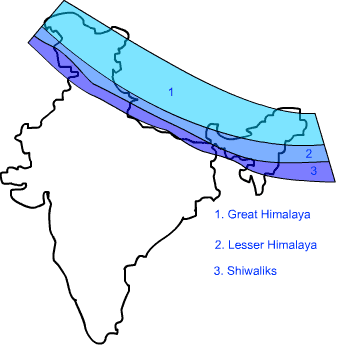The Himalayan Mountains : Physical Features of India - Class 9 PDF Download
Physical Features of India
The Himalayan Mountains
The Himalayas are the youngest mountains in the world and are, structurally, the folded mountains. The Himalayas run along the northern border of India. The Himalayas form an arc which is about 2,400 km long. The width varies from 400 km in Kashmir to 150 km in Arunachal Pradesh. The altitudinal variations are greater in the eastern part than in the western part. There are three parallel ranges in its longitudinal extent.

(1) The Great or Inner Himalayas:-
This is the northernmost range and is also known as ‘Himadri’. This is the most continuous range. It contains the loftiest peaks. The average height of peaks in this range is 6,000 metres. All the prominent Himalayan peaks are in this range. The folds of the Great Himalayas are asymmetrical in nature, and the core of this part is granite. Because of the lofty heights, the peaks of this range are perennially snow-bound.
(2) The Lesser Himalaya or Himachal:
This lies towards the south of the Great Himalayas. The altitude of peaks in this range varies from 3,700 m to 4,500 m. The average width of this range is 50 km. This range is mainly composed of highly compressed and altered rocks.
(3) The Shiwaliks:-
This is the outermost range of the Himalayas. The altitude varies between 900 and 1100 km in this range and the width varies between 10 to 50 km. These ranges are composed of unconsolidated sediments. The longitudinal valleys lying between the Himachal and Shiwaliks are called ‘Dun’.

Himalayan Regions from East to West:
- Punjab Himalayas:- This part lies between the Indus and Sutlej. From west to east, this is also known as the Kashmir Himalaya and Himachal Himalaya.
- Kumaon Himalayas: This part lies between the Sutlej and Kali rivers.
- Nepal Himalayas: This part lies between the Kali and Tista rivers.
- Assam Himalayas: This part lies between the Tista and Dihang rivers.
Eastern hills and mountains: The Brahmaputra marks the eastern border of the Himalayas. Beyond the Dihang gorge, the Himalayas bend sharply towards the south and form the Eastern hills or Purvachal. These hills run through the northeastern states of India. They are mostly composed of sandstones. These hills are composed of the Patkai Hills, Naga Hills, Manipuri Hills and Mizo Hills.
The Northern Plain
The northern plain of India is formed by three river systems, viz. the Indus, the Ganga and the Brahmaputra, along with their tributaries. This plain is composed of alluvial soil, which has been deposited over millions of years. The total area of the northern plain is about 7 lakh square kilometers. It is about 2400 km long and about 240 to 320 km broad.

The northern plain is divided into three sections, viz., the Punjab Plain, the Ganga Plain and the Brahmaputra Plain.
- Punjab Plains: The Punjab plains form the western part of the northern plain. This is formed by the Indus and its tributaries; like Jhelum, Chenab, Ravi, Beas and Sutlej. A major portion of this plains is in Pakistan. Doabs abound in this plain.
- Ganga Plains: This plain extends between the Ghaggar and Tista rivers. The northern states, Haryana, Delhi, UP, Bihar, part of Jharkhand and West Bengal lie in the Ganga plains.
- Brahmaputra Plains: This plain forms the eastern part of the northern plain and lies in Assam.
Based on the relief features, the northern plain can be divided into four regions, viz. bhabar, terai, bhangar and khadar.
- Bhabar: After descending from the mountains, the rivers deposit pebbles in a narrow belt. The width of this belt is about 8 to 16 km and it lies parallel to the Shiwaliks. This region is known as bhabar. All the streams disappear in this region.
- Terai: The Terai region lies towards the south of the Bhabar belt. In this region, the streams reappear and make a wet, swampy and marshy region.Question for The Himalayan Mountains : Physical Features of IndiaTry yourself:Which region in the northern plain is composed of the oldest alluvial soil?View Solution
- Bhangar: Bhangar is the largest part of the northern plain and is composed of the oldest alluvial soil. They lie above the floodplains. They resemble terraces. The soil of this region is locally known as kankar and is composed of calcareous deposits.
- Khadar: The floodplains formed by younger alluvium are called khadar. The soil in this region is renewed every year and is thus highly fertile.
FAQs on The Himalayan Mountains : Physical Features of India - Class 9
| 1. What are the major physical features of India? |  |
| 2. What is the significance of the Himalayan Mountains in India? |  |
| 3. How do the Himalayan Mountains impact the climate of India? |  |
| 4. What is the geological significance of the Himalayan Mountains? |  |
| 5. How does the Himalayan ecosystem support biodiversity in India? |  |

|
Explore Courses for Class 9 exam
|

|


















